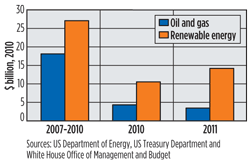Oil and Gas in the Capitals
Oil and gas subsidies in perspective
Oil and gas subsidies in perspective
There is a widespread perception that US federal energy policies provide enormous subsidies and incentives to the oil and gas industry while offering relatively little to renewable energy. This refrain was heard at a March 17 hearing of the US House Natural Resources Committee; in his opening statement, ranking minority member Rep. Edward J. Markey (D-Mass.) reportedly called US energy policy a horserace between subsidized traditional fossil fuels and underfunded new technologies that have been trapped in the starting gate. This purported imbalance is frequently invoked by special interest groups arguing in favor of vastly increased federal support for renewable energy. However, as is often the case, the conventional wisdom here is wrong. In fact, there is a large imbalance in federal incentives for various forms of energy, but the imbalance is strongly in favor of renewables, and is increasing rapidly. Consider the following budget and tax expenditure data, drawn primarily from the US Department of Energy, the US Treasury Department and the White House Office of Management and Budget: • From 2007 through 2010, the oil and gas industry received about $18 billion in total federal incentives, whereas federal incentives for the renewable energy industry totaled about $27 billion, 50% higher. • In 2010 alone, oil and gas received about $4.1 billion in federal incentives, whereas federal incentives for renewable energy totaled nearly $10.5 billion—more than 2.5 times as much. • In 2011, it is estimated that oil and gas will receive a little over $3 billion in federal incentives, whereas federal incentives for renewable energy will be nearly five times that amount, totaling more than $14 billion.
The federal government encourages and promotes the development of domestic energy resources in many diverse ways. Federal incentives for energy include direct subsidies, shouldering of regulatory costs (when not covered by producer fees), tax reductions, market support, demonstration programs, research and development funding, procurement mandates, information generation and dissemination, technology transfer and directed purchases. The oil and gas industry receives substantial financial benefits from tax incentives, such as the tax deductions for intangible drilling and development costs and for percentage depletion. In 2010, oil and gas companies benefited $2 billion and $600 million, respectively, from these deductions. But renewables also receive substantial financial benefit from tax incentives, such as the renewable electricity production tax credit, tax credits for holding clean renewable energy bonds, biodiesel and small agri-biodiesel producer tax credits, the alcohol fuel credit, and the renewable transportation fuels and volumetric ethanol excise tax credit. In 2010, renewable energy producers benefited $1.2 billion from the alcohol fuels credit and $6.1 billion from the volumetric ethanol excise credit. For both industries, most federal incentives are in the form of tax expenditures. Meanwhile, renewable energy receives about $1 billion in federal R&D funds, whereas federal R&D funding for oil and gas is negligible. Furthermore, these discrepancies are not of recent vintage. Again contrary to conventional wisdom, renewable energy technologies have been heavily subsidized and promoted by the federal government since at least the 1970s. Some have been subsidized even longer; for example, photovoltaics received substantial federal support as early as the 1950s. Finally, it should also be noted that these two general categories of resources provide very different contributions to the US energy mix. In 2010, oil and gas provided 62% of US energy consumption, whereas renewables provided about 5%. And even that is misleadingly high, since about half of what is considered renewable energy production consists of direct burning of scrap wood and byproducts in the wood, paper and paper products industries, at a rate that has remained relatively constant over the past century. Thus, considering only those renewable energy resources for which environmentalists want to increase incentives (biofuels, wind, solar, etc.), the actual contribution to the US energy mix is closer to 2.5%. This information is not meant to imply that either oil and gas or renewables receive too much or too little federal support. The issue of appropriate levels and types of federal incentives for energy is an extremely complex and highly controversial one about which numerous studies, papers and books have been written—and well outside the scope of this column. Nevertheless, the data summarized here do provide useful insight into an important topic—one that is very timely given the current acrimonious debate in Congress over federal spending, tax and energy policies. With all due deference to Rep. Markey, federal incentives for renewable energy producers are much larger than those for “big oil,” and this imbalance is growing. This is an important fact to remember the next time you hear or read that renewable energy is being starved of federal funding, while the oil and gas industry is being subsidized prodigiously. WO
|
|||||||||||||
- Applying ultra-deep LWD resistivity technology successfully in a SAGD operation (May 2019)
- Adoption of wireless intelligent completions advances (May 2019)
- Majors double down as takeaway crunch eases (April 2019)
- What’s new in well logging and formation evaluation (April 2019)
- Qualification of a 20,000-psi subsea BOP: A collaborative approach (February 2019)
- ConocoPhillips’ Greg Leveille sees rapid trajectory of technical advancement continuing (February 2019)




